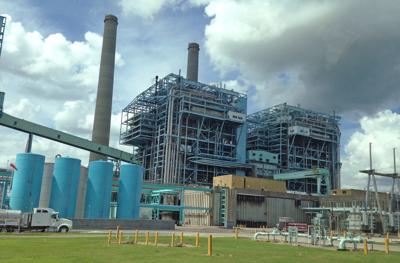Louisiana coal-fired power plants, including units in Lake Charles, New Roads and Lena, could be forced to reduce carbon emissions by 90% as well as reduce other pollutants under new rules announced by the federal Environmental Protection Agency.
The carbon emission rules announced Thursday will also apply to new natural gas combustion turbines used to generate electricity, often the energy source preferred for taking the place of coal-fired electric plants. It's unclear whether there are any new Louisiana plants being planned that would fall under the rules.
EPA officials say the new rules will reduce carbon pollution by 1.38 billion metric tons through 2047, the equivalent of taking 328 million gasoline-fueled cars off the road, or almost a full year of emissions now generated by the nation’s electric power plants.
The rules are part of a broader, national strategy to reduce emissions that are causing global warming. Under the rule, plants must also reduce emissions of toxic metals by 67%, reduce pollutants in wastewater and clean up existing and no longer used coal ash disposal areas.
Because the carbon emission reduction will be accompanied by a reduction in other pollutants, EPA says the rules also are projected to result in $370 billion in climate and public health net benefits over the next 20 years.
In 2035, the reductions would result in 1,200 avoided premature deaths, 870 avoided hospital and emergency visits, 1,900 avoided cases of asthma onset, 360,000 avoided cases of asthma symptoms, 48,000 avoided school absence days and 57,000 avoided lost workdays.
EPA officials said both existing coal-fired and new natural gas plants would be expected to turn to carbon capture and sequestration — the injection of carbon captured at the power plants deep underground — as the most cost-effective emission control technology.
Louisiana earlier this year was granted “primacy” by the EPA to issue permits for carbon sequestration facilities in the state. At the time, EPA said it was transferring 22 sequestration applications to the state for permitting, and state officials said they expected additional permit requests to be made as more sequestration facilities were proposed.
The four coal-fired plants in Louisiana are:
- Entergy Louisiana’s R.S. Nelson plant in Lake Charles
- Two coal-fired units at Big Cajun 2, one co-owned by Entergy and CLECO, and the other owned by CLECO, in New Roads
- Two units of the Brame Energy Center in Lena, including the Madison 3 unit 100% owned by Cleco that uses 30% coal and 70% petroleum coke, and the Rodemacher 2 unit fueled only by coal that is 30% owned by Cleco and the rest owned by Louisiana Energy and Power Authority and Lafayette Utilities System.
A spokesperson for Entergy said the company, which also owns coal-fired power plants in other states, is evaluating the rule for impacts on the company’s operations.
“We continuously evaluate the right mix of generation resources to meet the needs of our customers, and update those plans when appropriate in response to changing circumstances,” said spokesperson Brandon Scardigli.
“Coal generation is a minimal part of Entergy’s generation portfolio today, totaling 8% of owned and leased generating capacity in 2023. We announced in 2020 plans to retire all of our coal-powered capacity by the end of 2030. This final rule allows us to proceed with that commitment while providing safe, affordable and reliable power without imposing additional costs on our customers.”
He said the company remains committed to achieving a net-zero level of greenhouse gas emissions by 2050.
Cleco is "beginning to review the new EPA rules released today and will analyze how these rules might impact our business and operations," said Maile Murray, director of environmental health and safety. "It is Cleco's policy to conduct its business in an environmentally responsible manner. This responsibility includes compliance with environmental laws and regulations and efforts beyond compliance which provide for the protection of public health and the environment.”
The Sierra Club used EPA’s announcement to again call on Cleco to commit to retiring its coal-fired plants.
“People across Louisiana deserve to breathe clean air, and these regulations will improve air quality for us all,” said Emma Hopkins, Sierra Club field organizer for Louisiana and Arkansas, adding that the company should abandon its plan to build a $1.4 billion carbon capture facility for the Madison 3 unit.
“Ratepayer dollars … would be better invested in renewables, energy efficiency programs, and transmission,” she said. “Moreover, (carbon capture) will not do anything to reduce Madison 3’s massive emissions of other harmful pollutants, like sulfur dioxide, nitrogen oxides, and soot which can cause asthma and even premature death.”
The U.S. Chamber of Commerce raised concerns about the effects of the new rule on the development of future electricity supplies.
“We are reviewing the final rule but are increasingly concerned with the administration’s contradictory approach to energy policy,” said Marty Durbin, the chamber’s senior vice president of policy. “With near daily reminders that electricity demand will increase exponentially — for data centers, AI, new manufacturing facilities, and the ever-increasing electrification of the economy — we are concerned the rule would significantly restrict electricity supply necessary to meet that demand."
The state Department of Environmental Quality, which likely will have to enforce the new rules, was still assessing the new rule, said Stacey Holley, new chief of staff and first assistant to DEQ Secretary Aurelia Giacometto.
A spokesperson for Louisiana Attorney General Liz Murrill declined to say whether she would challenge the new rules in court.

